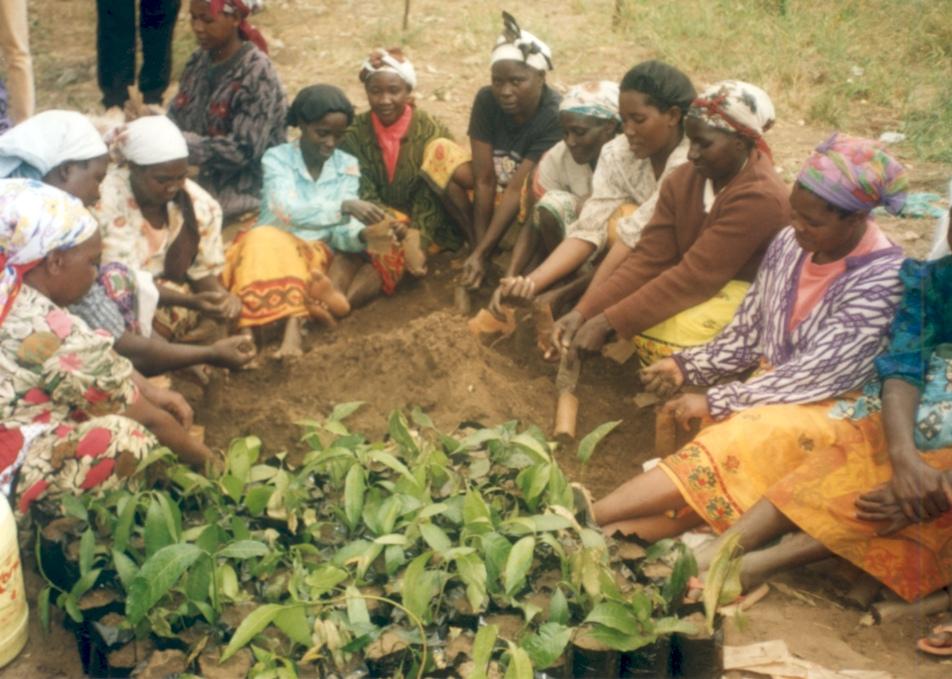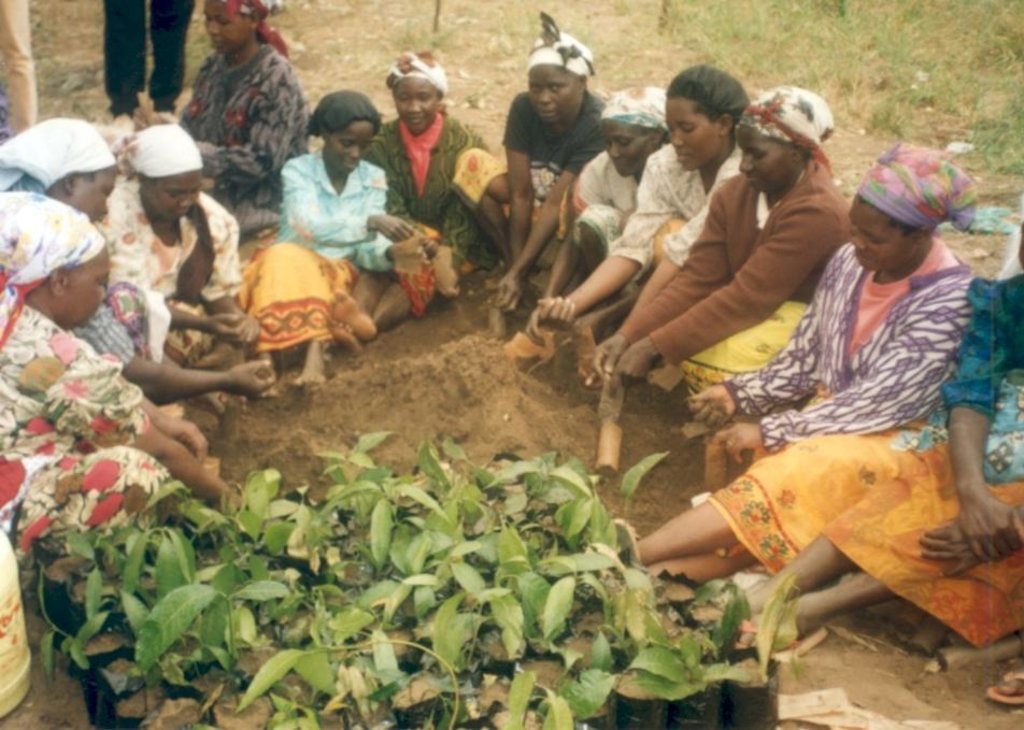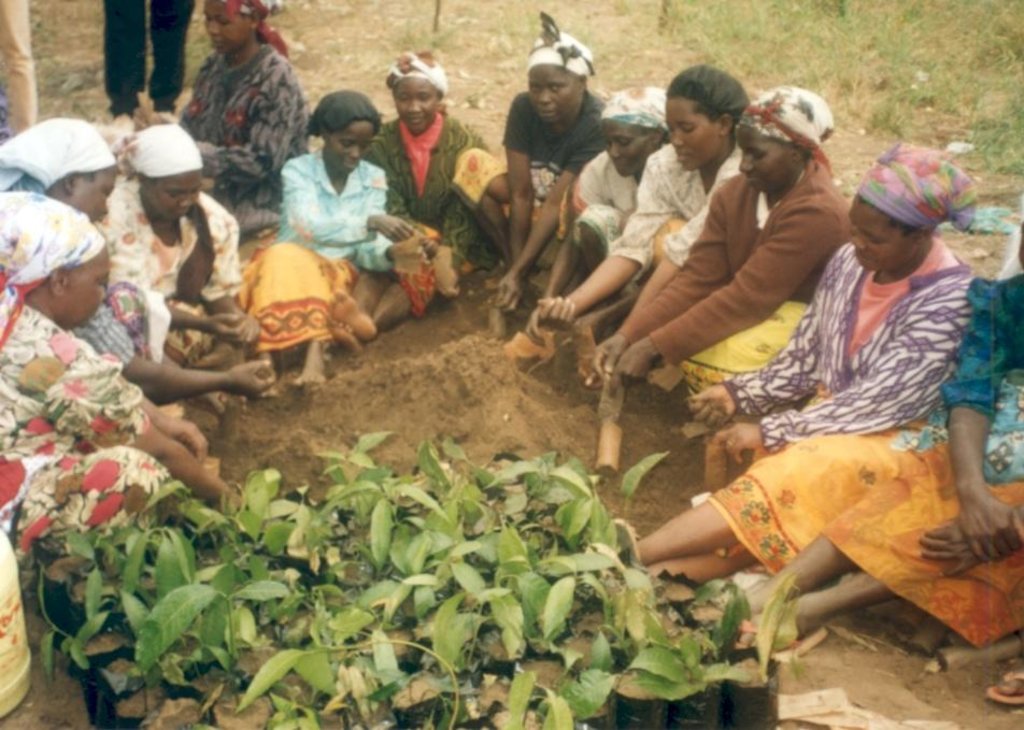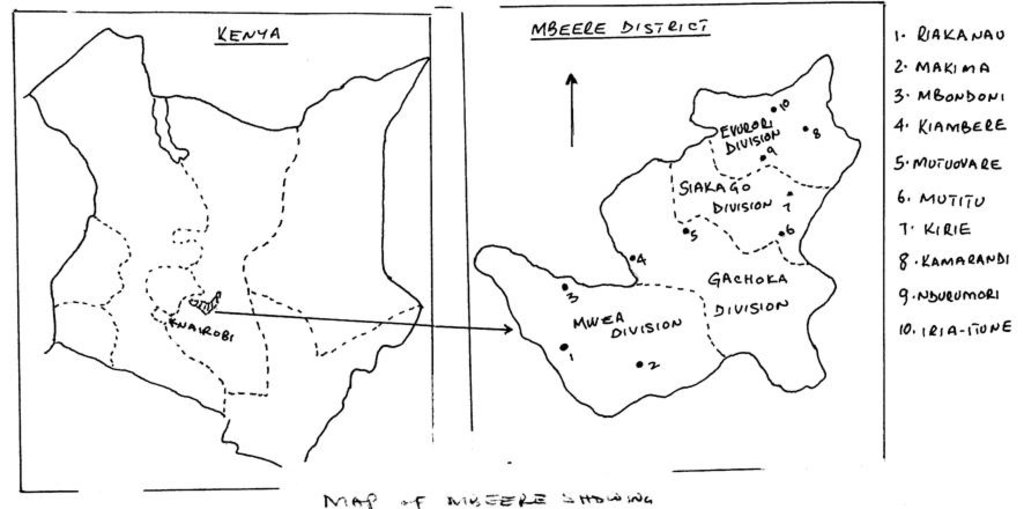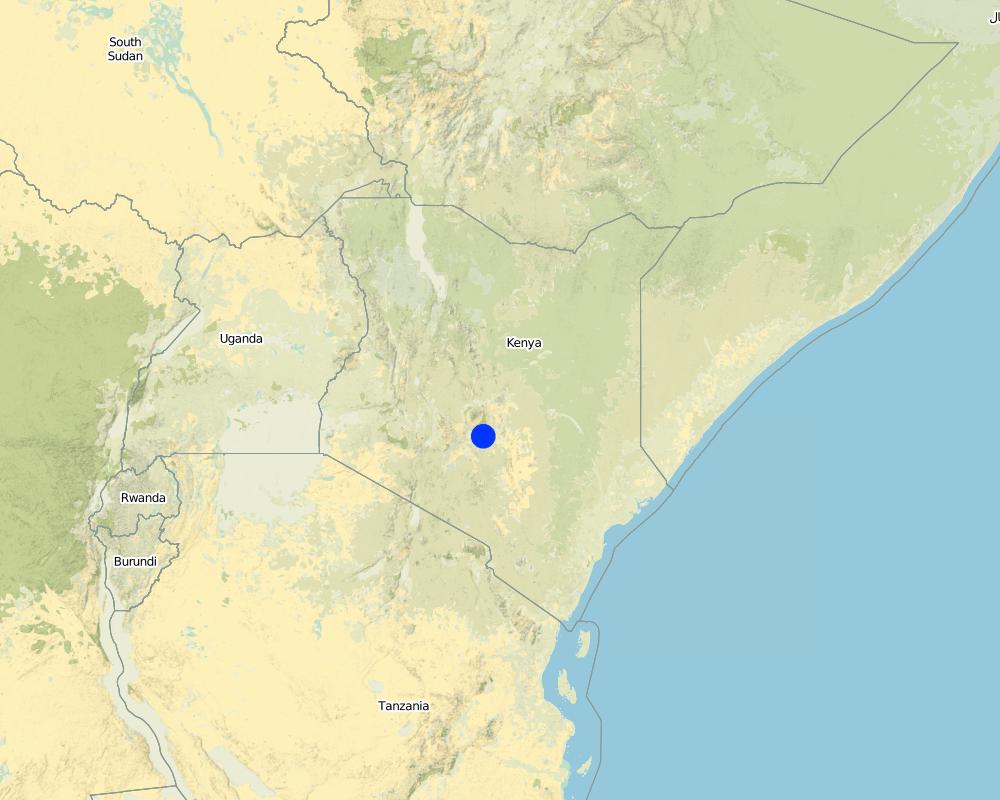Cash for Work [肯尼亚]
- 创建:
- 更新:
- 编制者: Boniface, Mutegi Birichi
- 编辑者: –
- 审查者: Fabian Ottiger
approaches_2360 - 肯尼亚
查看章节
全部展开 全部收起1. 一般信息
1.2 参与方法评估和文件编制的资源人员和机构的联系方式
SLM专业人员:
Wamuyu Joseph
016120368
Diocese of Embu
Box 884
肯尼亚
SLM专业人员:
Ireri Vincent
016120368
Diocese of Embu
Box 884
肯尼亚
有助于对方法进行记录/评估的机构名称(如相关)
Embu Diocese - 肯尼亚1.3 关于使用通过WOCAT记录的数据的条件
编制者和关键资源人员接受有关使用通过WOCAT记录数据的条件。:
是
2. SLM方法的描述
2.1 该方法的简要说明
Giving cash incentives to farmers for them to undertake soil and water conservation
2.2 该方法的详细说明
该方法的详细说明:
Aims / objectives: Overall purpose of reducing vulnerability to famine and recurrent drought in Mbeere district. Specific objectives were to increase access to cash to meet basic needs of some 2000 most vulnerable households for a period of 4 months and to increase adoption of improved drought tolerant crop varieties for some 2000 most vulnerable households for aperiod of 9 months.
Methods: Methods of delivery were cash for work in construction of SWC structures including rural access road improvement and provision of access to planting seeds, technical knowhow and drought tolerant crop varieties.
Stages of implementation: Stages of implementation were sensitization and awareness creation of key stake holders and land users, Recruitment of technical staff and their training , selection of the beneficiaries and formation of groups ( 10 groups each comprising 20 farmers ) per work site, Election of focal area committees and their training, actual implementation of the agreed activities and finally monitoring and evaluation.
Role of stakeholders: Role of the participants was to provide labour, undertake good crop husbandry practices on the conserved land and participate in meetings, field days and group activities.
2.3 该方法的照片
2.5 采用该方法的国家/地区/地点
国家:
肯尼亚
区域/州/省:
Mbeere Distict In Eastern Province
Map
×2.6 该方法的开始和终止日期
注明开始年份:
2000
终止年份(若不再采用该方法):
2002
2.7 方法的类型
- 基于项目/方案
2.8 该方法的主要目的/目标
The Approach focused mainly on SLM with other activities (*Water harvesting for crop productioin *Access roads improvement *Fruit trees establishment *Increased adoption of improved drought tolerant crop varieties)
*Increase access to cash so as to meet basic needs of the most vulnerable households *Consruction of soil and water conservation measures including improvement of access roads in the focal area ( work site ). *Increased adoption of improved drought tolerant crop varieties.
The SLM Approach addressed the following problems: * low land productivity due to soil erosion and drought *Migration of farmers to look for work during drouht speells *Poor access roads * Lack of seeds for improved drought tolerant crop varieties
2.9 推动或妨碍实施本办法所适用的技术的条件
财务资源和服务的可用性/可得性
- 阻碍
migration to look for off farm employment
Treatment through the SLM Approach: cash incentives to make the farmers remain in their farms and do conservation
法律框架(土地使用权、土地和水使用权)
- 启动
The existing land ownership, land use rights / water rights greatly helped the approach implementation: Individual land ownership encouraged the farmers to invest on their through various conservation efforts
了解SLM,获得技术支持
- 阻碍
Lack of adquate technical staff to lay out soil and water conservation measures
Treatment through the SLM Approach: Training work site (focal area) farmer commitees to do lay out work ie paraprofessionals.
其他
- 阻碍
inadequate family labour on the farms
Treatment through the SLM Approach: Organise farmers into conservation groups ie communal work
3. 相关利益相关者的参与和角色
3.1 该方法涉及的利益相关者及其职责
- 当地土地使用者/当地社区
Working land useres where work is equally divided between men and women
The programme targeted the resource poor land users ie those that were already receiving food relief from the World food Programme (WFP).
- NGO
Diocese of Embu
- 国家政府(规划者、决策者)
Ministry of agriculture
- 国际组织
Catholic Relief Services (CRS)
3.2 当地土地使用者/当地社区参与该方法的不同阶段
| 当地土地使用者/当地社区的参与 | 指定参与人员并描述活动 | |
|---|---|---|
| 启动/动机 | 被动 | public meetings; Series of work site meetings to explain the programme to the land users |
| 计划 | 互动 | Mainly: public meetings; partly: workshops/seminars; Workshops for key staholders held and training of the programme staff conducted |
| 实施 | 外部支持 | Mainly: casual labour; partly: responsibility for major steps; Wor site committees were responsible for organising the farmers day to day activities |
| 监测/评估 | 互动 | Mainly: measurements/observations; partly: public meetings, reporting; Focal area committees were assisting the technical staff in taking measurements compiling reports |
| Research | 互动 | on-farm; The mother (16 varieties ) and baby (3 varieties) trials were managed by the farmers |
3.4 有关SLM技术选择的决策
具体说明谁有权决定选择要实施的技术:
- 主要是SLM专家,咨询土地使用者之后
解释:
Consultative. Meetings were held with the land users where the activities to be undertaken were discussed and agreed on.
Decisions on the method of implementing the SLM Technology were made by mainly by SLM specialists with consultation of land users. Consultative. The method was chosen by the SWC specialists but discussed and adopted by the farmers
4. 技术支持、能力建设和知识管理
4.1 能力建设/培训
是否为土地使用者/其他利益相关者提供培训?:
是
明确受训人员:
- 土地使用者
- extensionists/trainers
培训形式:
- 在职
- 农民对农民
涵盖的主题:
Methods of soil conservation; Water harvesting for crop production; Lay out of soil conservation structures and tree planting
4.2 咨询服务
土地使用者有权使用咨询服务吗?:
是
指明是否提供了咨询服务:
- 在土地使用者的土地上
- 在固定中心
说明/注释:
Name of method used for advisory service: catchment (focal area) approach; Key elements: demonstrations, field days, trial plots and individual farm visits; 1) Mainly: government's existing extension system, Partly: projects own extension structure and agent 2) Mainly: government's existing extension system, Partly: projects own extension structure and agent; Extension staff: mainly government employees 3) Target groups for extension: land users; Activities: lay out work, agroforestry, individual tree nurseries establishment
Advisory service is quite adequate to ensure the continuation of land conservation activities; proramme used the existing extension staff within the focal areas. These staff arec still in place continously delivering extension services
4.3 机构强化(组织发展)
是否通过这种方法建立或加强了机构?:
- 是,适度
具体说明机构的强化或建立程度:
- 本地
具体说明支持类型:
- 能力建设/培训
- logistical surpport-transport
4.4 监测和评估
监测和评估是该方法的一部分吗?:
是
注释:
technical aspects were regular monitored
economic / production aspects were regular monitored
area treated aspects were regular monitored by 0 through measurements; indicators: None
no. of land users involved aspects were None monitored by 0 through None; indicators: None
There were no changes in the Approach as a result of monitoring and evaluation: None
4.5 研究
研究是该方法的一部分吗?
是
明确话题:
- 技术
提供进一步的细节,并指出是谁做的研究:
adaptive onfarm trials carried out on new drought tolerant crop varieties
Research was carried out on-farm
5. 融资和外部物质支持
5.1 该方法中SLM组成部分的年度预算
如果不知道准确的年度预算,请给出一个范围:
- 100,000-1,000,000
注释(例如主要的资助来源/主要捐助者):
Approach costs were met by the following donors: international non-government (Catholic relief services): 99.0%; local community / land user(s) (Depreciation of farm tools): 1.0%
5.2 为土地使用者提供财政/物质支援
土地使用者是否获得实施该技术的财政/物质支持?:
是
如果是,请具体说明支持的类型、条件和提供者:
In addition to the cash the land users were given seeds and fruit tree seedlings
5.3 对特定投入的补贴(包括劳动力)
- 设备
| 具体说明哪些投入得到了补贴 | 程度如何 | 对补贴做出具体说明 |
|---|---|---|
| 机械 | ||
| 工具 | ||
- 农业
| 具体说明哪些投入得到了补贴 | 程度如何 | 对补贴做出具体说明 |
|---|---|---|
| 种子 | 部分融资 | |
- 基建
| 具体说明哪些投入得到了补贴 | 程度如何 | 对补贴做出具体说明 |
|---|---|---|
| Community infrastructure | ||
注释:
In addition to the cash the land users were given seeds and fruit tree seedlings
5.4 信用
是否根据SLM活动的方法给予信用值?:
否
6. 影响分析和结论性陈述
6.1 方法的影响
该方法是否帮助土地使用者实施和维护SLM技术?:
- 否
- 是,很少
- 是,中等
- 是,支持力度很大
incorporation of water harvesting techniques in crop production and manure application
该方法是否改善了阻碍SLM技术实施的土地使用权/用户权问题?:
- 否
- 是,很少
- 是,中等
- 是,支持力度很大
Did other land users / projects adopt the Approach?
- 否
- 是,很少
- 是,中等
- 是,支持力度很大
The approach to spread to several other districts
6.3 方法活动的可持续性
土地使用者能否维持通过该方法实施的措施(无外部支持的情况下)?:
- 是
6.4 该方法的长处/优点
| 土地使用者眼中的长处/优势/机会 |
|---|
| training (How to sustain/ enhance this strength: more field days and farmer tours) |
| provision of seeds and seedlings (How to sustain/ enhance this strength: setting up of bulking plots and group tree nurseries) |
| cash provision (How to sustain/ enhance this strength: intensify production of cash generating enterprises especially fruit trees like mangoes and pawpaws) |
| 编制者或其他关键资源人员认为的长处/优势/机会 |
|---|
| group approach (How to sustain/ enhance this strength: training of the committees, encourage more group activities and projects) |
| involvement and use of locally based extension staff |
6.5 该方法的弱点/缺点以及克服它们的方法
| 土地使用者认为的弱点/缺点/风险 | 如何克服它们? |
|---|---|
| lack of appropriate tools | provision of suitable tools as the condition of the area dictate |
| 编制者或其他关键资源人员认为的弱点/缺点/风险 | 如何克服它们? |
|---|---|
| use of cash as incentive | should be phased out gradually |
| low land user involvement in the initial stages | use of participatory methods |
7. 参考和链接
7.2 参考可用出版物
标题、作者、年份、ISBN:
Catchment planning- by E.Mwenda , MOA&RD-Nairobi
Mbeere district development plan 1997-2002
链接和模块
全部展开 全部收起链接
无链接
模块
无模块


